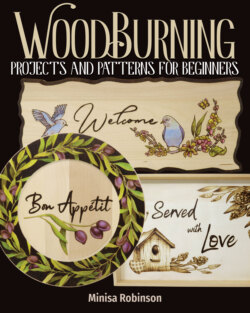Читать книгу Woodburning Projects and Patterns for Beginners - Minisa Robinson - Страница 20
На сайте Литреса книга снята с продажи.
ОглавлениеChapter 3
WOOD TYPES
There are many different types of wood that can be burned on safely. I’ll be covering some of the more common and easily accessible wood species in this chapter. Remember that even a safe type of wood becomes dangerous to burn once it has been clear-coated, painted, treated, etc. Always burn on unfinished wood only. If you’re unsure whether or not you can burn on a particular species of wood, please contact a forestry specialist.
Basswood
Basswood is one of the most popular woods to burn on and is certainly my personal preference. It can be a little more expensive that other common wood types, but it can make a huge difference in your quality of work. Basswood is also known as linden and is found in eastern North America. It has a very light color, with minimal grain and growth rings, which makes it especially nice to burn on. Since it is a popular wood for woodburning artists and carvers alike, basswood comes in a variety of different sizes, styles, and cuts.
The lighter color of basswood makes it great for a wide range of tones, from jet blacks to blonde highlights.
Other popular surfaces for pyrography include:
• Maple
• Italian poplar
• Watercolor paper
• Gourds
• Leather
Birch
Birch is quite light, and it has an overall uniform appearance with minimal grain. It’s often sold in panels of a variety of thicknesses that are glued to thicker panels for support. If you choose to burn on birch panels, be sure you don’t burn deeply into the lower layers of glue. (As a personal rule, I never burn solid black backgrounds on any plywood-based wood to avoid releasing potentially toxic fumes.)
Pine
Pine is usually inexpensive and easy to find at most craft stores and lumberyards. However, it can be challenging to burn on. The heavy grain can cause your point to zig and zag, which makes it difficult to burn straight lines. Some artists have good luck burning on “kiln-dried” pine, but most pieces of pine that are readily available haven’t gone through this process. Therefore, pine contains a lot of pitch and creates a lot of smoke when burned on.
If you choose to burn on pine, I recommend using a respirator suited for particulates or work in a well-ventilated area.
Cherry
Cherry is a beautiful wood that is quite soft. Even though the grain is very visible, the lines don’t interfere with the point of the burner. This wood burns on the darker side very easily, and lighter shading produces a slightly reddish tint.
Because cherry is darker than other woods, adding paint or colored pencils after burning can produce amazingly vivid results.
Butternut
Much like cherry, butternut is also a darker wood and is quite soft. I find that it is well suited to darker subjects and it combines nicely with paint or colored pencils. These butternut slices are quite large, with some interesting knots and irregularities. I purchased these from a private supplier, but you can find them online from specialty lumberyards.
